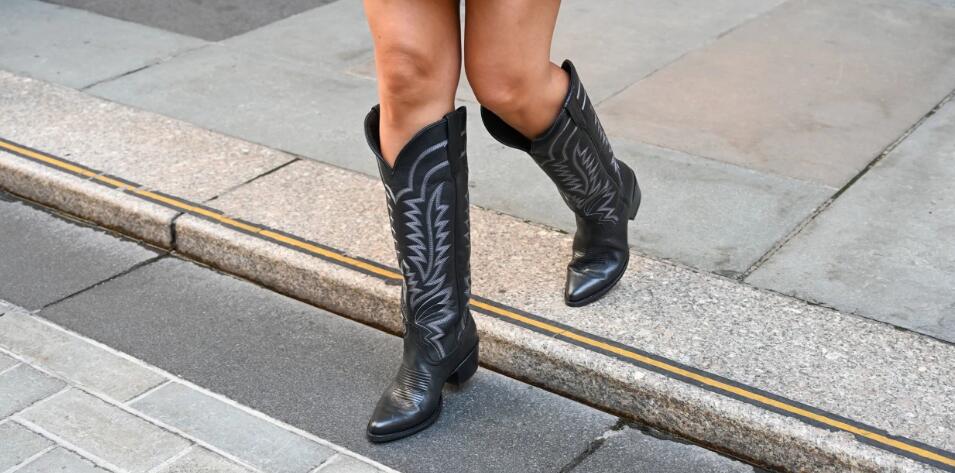With sweater weather on the horizon, we’ve been itching to break out our favorite fall staples, from cozy leggings to our beloved fall boots. And with western styles being pretty trendy recently (think coastal cowgirl!), now is the perfect time to add a bit of extra flair to your wardrobe. When it comes to embodying the spirit of the Wild West, cowboy boots are one of the most versatile ways to go about it.
TikTok (where almost all of the biggest fashion trends originate of late) is also a fan of the style. Videos featuring the #cowboyboots tag have more than one billion collective views on the app. According to Google Trends, the search for “cowboy boots” is on the rise as fall approaches, with specific terms like “tall black cowboy boots” seeing a 60% percent spike.
However, is this trend good for your feet? We asked foot and ankle surgeon Dr. Buck Smith M.D., style expert Amy E. Goodman and footwear designer Elizabeth Ruiz on how to find the right style and fit for you.
Why are cowboy boots trending?
Thanks in part to a trend that stemmed from coastal grandmother, coastal cowgirl took TikTok by storm, implementing usual summer outfits with hints of western wear such as cowboy boots and hats.
Ruiz believes cowboy boots are trending because of their “classic style, versatility and the fashion industry’s continued interest in western-inspired designs.”
Are there different kinds of cowboy boots?
Just like there are different types of sneakers, there are different types of cowboy boots. What sets them apart are the materials they’re made out of, their height, width and toe.
“Cowboy boots can be made out of various materials, including traditional leather and suede or exotic skins (such as alligator),” suggests Ruiz.
The material they’re made out of can help determine their durability and longevity, adds Ruiz. For example, boots made out of faux leather might not be as durable or last as long compared to those made out of traditional leather or animal skin.
Also, the height and width of cowboy boots play into the type of look you’re going for. Wearing a mini skirt? Taller boots might be the move. Rocking bootcut jeans? A shorter boot could be your best bet. The width all depends on your calf size. Many brands offer width options, while some don’t.
Finally, there are four “distinct” toe types a boot can come in: pointed, snip, square and round.
Do’s and don’ts of cowboy boots
- Do break them in gradually. Ruiz advises against going 0 to 100 and packing a brand new pair of boots for a girl’s trip to Nashville, for example. “Wear them for short periods initially to avoid discomfort,” she says.
- Do use boot trees. Boot trees are wooden structures placed inside cowboy boots to keep their shape and form when not in use. They also help to “prevent creasing,” says Ruiz.
- Do practice regular cleanings. “Wipe off dirt and stains with a damp cloth and use a leather cleaner or saddle soap specifically designed for cowboy boots when needed,” says Ruiz.
- Do condition the leather. To keep the leather looking like new, condition it regularly.
- Do wear in fair weather conditions. “Avoid prolonged exposure to water or wet conditions, as it can damage the leather and weaken the structure of the boots,” says Ruiz. Wearing your boots in extreme weather conditions can cause damage to the leather and structure of the boots.
- Don’t use harsh chemicals such as ammonia and bleach when cleaning, “as they can damage the leather and cause discoloration,” says Ruiz.
- Don’t let them dry in direct heat. Post-cleaning, don’t set them out in the sun or a warm spot to dry, or don’t use a hair dryer, as it “can cause the leather to crack or shrink,” according to Ruiz.
- Don’t store them when wet. Allowing them to air dry will help to prevent mold and mildew growth.
- Don’t force a bad fit. Forcing your feet into too small of a boot can lead to blisters and discomfort, while forcing your feet into too big of a shoe can cause them to fall off and have instability.
- Don’t use abrasive materials when cleaning, as they can damage the leather, says Ruiz. Use a microfiber towel or a brush.


